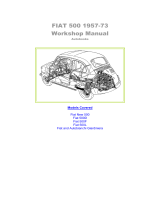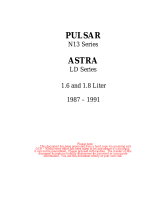
INTRODUCTION
Please read these instructions before installing the pedal assembly.
Installation instructions for other products from Tilton Engineering are available
at www.tiltonracing.com.
PEDAL ASSEMBLY MOUNTING
It is very important that the pedal assembly be mounted to a strong and rigid
structure. Flex in the supporting structure reduces control as much as a exible
pedal or air in the lines. The mounting must be strong enough to withstand the
loads of a driver’s legs in a panic situation.
See Diagram 1 for the pedal frame mounting pattern. Putting multiple mount-
ing holes in two tubes running fore/aft on the car will enable multiple mounting
positions, allowing the entire pedal assembly to be moved for dierent drivers.
Trial t pedal assembly in place. Make sure there is enough clearance with re-
wall to allow at least 1" of pushrod stroke for all master cylinders. Be sure to use
high quality ne thread fasteners for the six 5/16” or 8mm mounts on the oor,
along with proper full diameter washers. Proper mounting requires fasteners be
used in all six holes.
Note: If using an optional throttle linkage kit, please install it to
pedal frame prior to mounting pedal assembly to chassis.
BALANCE BAR SETUP
The 7/16” diameter balance bar (P/N 72-260) included with this pedal assembly
has been set at Tilton to have a 2.50” center-to-center distance for the master
clevises. Please conrm this distance prior to installing master cylinders. Refer
to balance bar instruction sheet (P/N 98-1250) for complete balance bar set-up
information, available for download at tiltonracing.com in the Installation
Instructions section.
REMOTE BIAS ADJUSTER ROUTING
As set at Tilton, the longer thread section of the balance bar is on the right-
side of the brake pedal. This is the end to which the remote bias adjuster cable
should be attached. If the cable is attached on the left-side of the pedal, remove
balance bar and rotate 180 degrees, so that the longer threaded side of the bar
is on the left.
Route the remote bias adjuster cable in a manner that will not interfere with
the throttle pedal or linkage. Secure the cable to the chassis, in a manner that
limits the number (and degrees) of bends in the cable and allows the adjuster to
operate smoothly.
THROTTLE LINKAGE
For a throttle connection system in the front of the pedal, please see Tilton's
optional throttle linkage system:
Mechanical Linkage - P/N 72-793 | Drive-By-Wire System - P/N 72-794
For mid and rear engine vehicles, an extension for attaching a throttle cable to
the pedal is available (P/N 72-183), as shown in Diagram 2. Modify the end to accept your
particular cable or linkage. There are three extension mounting positions on the
throttle pedal to provide a wide range of motion ratios.
In general, keep the extension as short as possible while maintaining proper
clearance for the foot and leg. A longer extension places a larger twisting load
on the pedal and does not allow the movement to be as free.
Master cylinders and throttle
linkage kit sold separately.
600-Series Underfoot Pedal Assemblies
INSTALLATION INSTRUCTIONS
98-1214
Diagram 1
Diagram 2
Bias Adjuster attached

MASTER CYLINDER MOUNTING
600-Series Underfoot Pedal Assemblies are designed to accept Tilton 76-Series master cylinders.
Secure the master cylinders to the pedal frame with the provided serrated ange nuts.
Master cylinder pushrods may be too long for some applications and may have to be shortened
to obtain correct pedal position (see Pedal Positioning & Adjustments). If you need to shorten
the pushrod, chamfer the end of the threads after cutting for easy adjustment (threading) of
pushrod length.
Attach the hydraulic lines to the master cylinders.
The brake system is gravity fed. Mounting the reservoirs above the caliper level is important to
maintaining a rm pedal, and is more reliable than using a residual pressure valve. Locate your
reservoirs accordingly.
Detailed bleeding instructions are included with every Tilton master cylinder kit. As with any
balance bar system, always bleed a front and rear caliper at the same time to allow full master
cylinder stroke.
PEDAL POSITIONING & ADJUSTMENTS
Foots pads can be adjusted vertically (pedal ratio), horizontally and in angle to suit driver prefer-
ences. See Diagram 3 and Diagram 4 for further detail.
The position of the brake and clutch pedals is set by adjusting the length of the master cylinder
pushrods. The position of the throttle pedal is set by adjusting the stop screws (if applicable).
Ensure the pushrods engage at least ½” (12mm) into the clevises. In short, set pedal position so
that the driver is comfortable and safe.
Pedal Ratios - The pedal ratios on this assembly can be adjusted by moving the foot pad
position. For available ratios, Ratios between 5.4:1 to 6.9:1 can be achieved
(See Diagram 4).
Brake Pedal - With the system properly bled, and the pedal depressed, the pedal should be verti-
cal or leaning slightly towards the driver. The driver should not be stretching their toes to reach
this pedal position, and their knees should be slightly bent. Keep in mind, as the race progresses,
any problems with pad knock back or fade will only increase the distance the pedal must travel.
Tighten the pushrod jam nuts after the pedal positioning is set.
Throttle Pedal - A good starting point for the throttle pedal position is to have it even with the
brake pedal in the depressed (full braking) position. This allows a driver who is completing their
braking maneuver with the right foot, to make a quick change back to the throttle. Some drivers
prefer the throttle to be slightly closer to them. Set the throttle stops accordingly and tighten the
jam nuts.
With the throttle linkage attached, adjust the throttle stop so that the engine throttle fully opens
without straining the cable or linkage. The positive stop must stop pedal movement, not the link-
age, which could bend or break.
Clutch Pedal - The position of the clutch pedal is mostly a matter of driver preference. Adjust the
pedal position accordingly and tighten the pushrod jam nuts.
Most racing clutch and release bearings require the use of a positive stop on the clutch pedal.
Setting this stop properly will prevent damage to the clutch and allow the clutch to release
cleanly. The clutch stop setting is usually 1/4" – 3/8” (6.4mm – 9.5mm) past the point of clean
clutch disengagement, measured at the foot pad.
FALSE FLOOR
Shown here, and in Diagram 5, are examples of a "False Floor"
for use with 600-Series Underfoot Pedal Assemblies.
FALSE FLOOR / HEEL REST REPRESENTATION
CUSTOMER SUPPLIED
NOTE: INSTALLER MUST ASSURE CLEARANCE
WITH THEIR THROTTLE LINKAGE COMPONENTS
THROUGH THEIR FULL TRAVEL!
Diagram 3
Diagram 4
Diagram 5
Tilton Engineering, Inc. 25 Easy Street • PO Box 1787 • Buellton, CA 93427 • www.tiltonracing.com
/












